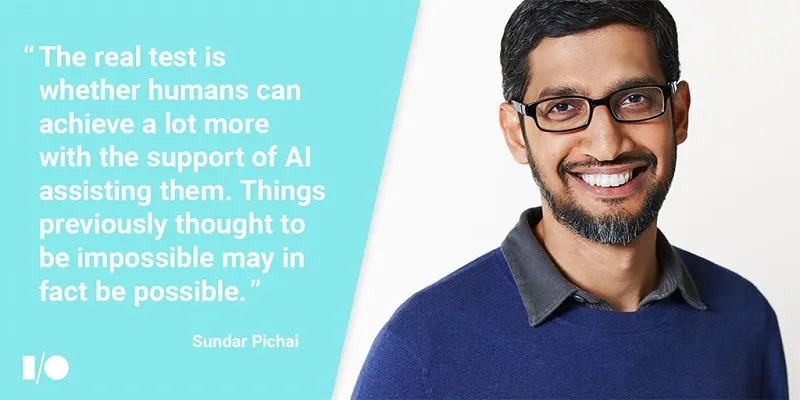Key highlights from Google I/O 2016 - Google Assistant, Home, Allo and Duo
On Thursday morning, Google CEO Sundar Pichai, officially kicked off Google I/O 2016, the company's annual developer conference at Shoreline Ampitheatre in Mountain View, California. Sundar remarked how times have changed since Google's first developer conference 10 years ago and also since Google was founded 17 years ago by Larry Page and Sergey Brin.
In the early days of the world wide web about 300 million people would connect to the internet through desktop machines. That number today has crossed 3 billion, with the majority using mobile devices as their primary way to get information and for a variety of other activities. Sundar noted,
We live in exciting times and it truly is the era of mobile phones. 50% of Google's queries come from mobile phones. Out of that, 1 in 5 queries from the US are voice queries.

Image credit- Google
Sundar also noted that as the mobile phone has become the remote control for our daily lives, Google’s mission “to organise the world’s information and make it universally accessible and useful” is truer and more important than ever before. For the past few years the company has been trying to dramatically improve the quality of voice recognition, image recognition and computer vision by leveraging the power of artificial intelligence (AI), machine learning and other technologies. Google seems to have cracked this with Google Assistant.
The Google assistant
With an estimated marketshare of over 85% and high accuracy rates, Google is currently the preferred search engine worldwide. But by utilising machine learning and artificial intelligence—specifically, areas like natural language processing, voice recognition and translation, Google aims to take this one step further with Google Assistant. Sundar Pichai described it this way,
Think of it as building a personal Google for everyone that is truly conversational. It’s a Google for you, by you.
Google noticed that as people were increasingly interacting naturally with Google, they weren’t just looking for the world’s information but actually expecting Google to help them with their daily tasks. So with Google Assistant, the search giant aims to have an ongoing two-way dialogue between the user and Google that will help people get things done. Google gave the audience a preview of two new products where users would soon be able to draw on the Google assistant.
Google Home
Positioned as a voice-activated product that brings the Google assistant into homes, Google Home lets users enjoy entertainment, manage everyday tasks, and get answers from Google—all using conversational speech.
With customisable bases in different colours and materials, Google Home is being designed to fit into different home environments. The product is expected to be released later this year.
Because of the stark similarities in many aspects, Google Home will likely be competing with Amazon's Echo, which already has a headstart in the market. Google though aims to stand out with additional features such as ability to sync audio playback to multiple devices and the ability to keep up with complex conversational voice commands.

Smart messaging with Allo
Allo is a smart messaging app that aims to make conversations easier, more expressive and help users get things done. It does this through deeply integrated machine learning through Google Assistant. Allo is based on phone numbers, so users can get in touch with anyone in their phonebook.
Allo has Smart Reply built in (similar to Inbox), so users can respond to messages without typing a single word for many use cases. The app also learns user behaviour overtime and will show suggestions based on the user's persona. For example, it will learn whether you’re more of a “haha” vs “lol” kind of person. The more you use Allo the more “you” the suggestions will become.
Allo also comes with fun ways to make chats more expressive, including emojis, stickers, and the ability to get creative with photos. Another interesting feature that was demoed on stage was - 'Whisper Shout' which lets users enlarge or shorten a word or emoji, by moving a slider up or down, in order to better convey tone.

Gif credit- Google blog
For the privacy conscious, there is also an 'Incognito mode' that provides end-to-end encryption, discreet notifications, and message expiration features.
It will be interesting to see how the other popular instant messaging apps like Whatsapp, Line and Telegram are affected by Allo, which provides many interesting value propositions.
One-to-one video calling with Duo
Google also announced Duo, a companion app for one-to-one video calling that lets users reach out to anyone in their phonebook. Duo includes a feature titled 'Knock Knock', which shows users a live video preview of the caller before they pick up the call. Once users answer the call, the app will seamlessly transition users right into the call.
To be launched on Android or iOS, Duo calls will be in crisp HD video (up to 720p) and audio; and for privacy reasons all calls will be end-to-end encrypted. In the official blog post the Google team also mentions,
We’ve optimized Duo to work well even on spotty networks, so if bandwidth is limited it gracefully adjusts quality so you’re still able to connect. We also seamlessly transition calls between cellular and Wi-Fi, so you don’t need to worry about what network you’re on.
For more details visit- Google I/O 2016







